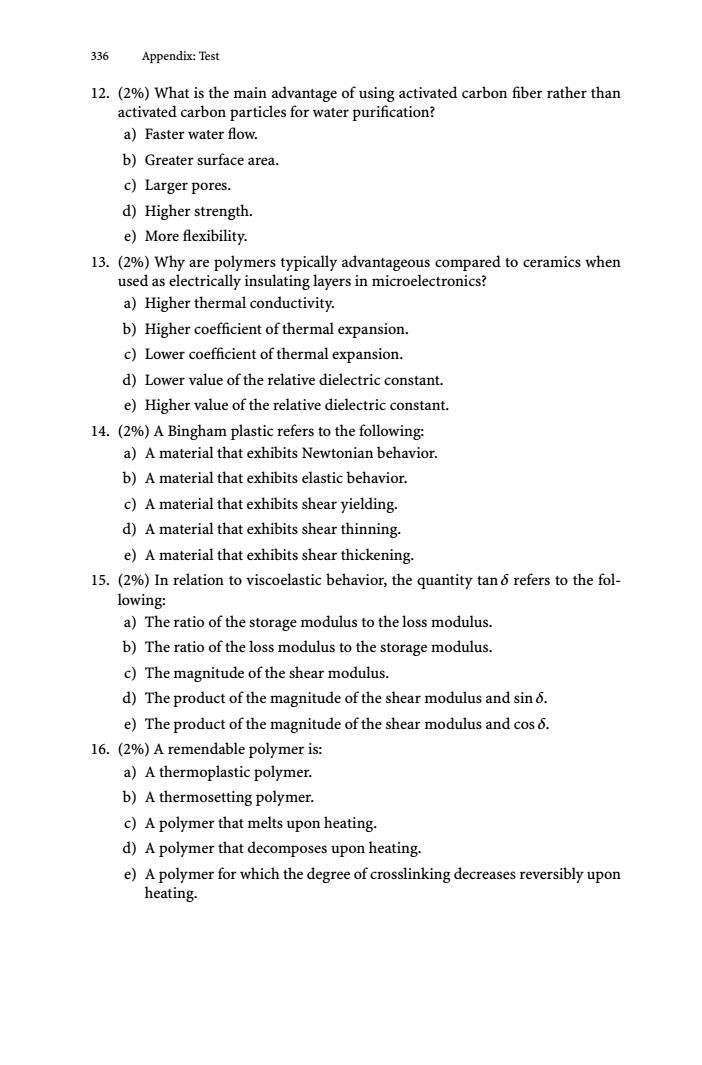正在加载图片...

336 Appendix:Test 12.(2%)What is the main advantage of using activated carbon fiber rather than activated carbon particles for water purification? a)Faster water flow. b)Greater surface area. c)Larger pores. d)Higher strength. e)More flexibility. 13.(2%)Why are polymers typically advantageous compared to ceramics when used as electrically insulating layers in microelectronics? a)Higher thermal conductivity. b)Higher coefficient of thermal expansion. c)Lower coefficient of thermal expansion. d)Lower value of the relative dielectric constant. e)Higher value of the relative dielectric constant. 14.(2%)A Bingham plastic refers to the following: a)A material that exhibits Newtonian behavior. b)A material that exhibits elastic behavior. c)A material that exhibits shear yielding. d)A material that exhibits shear thinning. e)A material that exhibits shear thickening. 15.(2%)In relation to viscoelastic behavior,the quantity tan 6 refers to the fol- lowing: a)The ratio of the storage modulus to the loss modulus. b)The ratio of the loss modulus to the storage modulus. c)The magnitude of the shear modulus. d)The product of the magnitude of the shear modulus and sin 6. e)The product of the magnitude of the shear modulus and cos 6. 16.(2%)A remendable polymer is: a)A thermoplastic polymer. b)A thermosetting polymer. c)A polymer that melts upon heating. d)A polymer that decomposes upon heating e)A polymer for which the degree of crosslinking decreases reversibly upon heating.336 Appendix: Test 12. (2%) What is the main advantage of using activated carbon fiber rather than activated carbon particles for water purification? a) Faster water flow. b) Greater surface area. c) Larger pores. d) Higher strength. e) More flexibility. 13. (2%) Why are polymers typically advantageous compared to ceramics when used as electrically insulating layers in microelectronics? a) Higher thermal conductivity. b) Higher coefficient of thermal expansion. c) Lower coefficient of thermal expansion. d) Lower value of the relative dielectric constant. e) Higher value of the relative dielectric constant. 14. (2%) A Bingham plastic refers to the following: a) A material that exhibits Newtonian behavior. b) A material that exhibits elastic behavior. c) A material that exhibits shear yielding. d) A material that exhibits shear thinning. e) A material that exhibits shear thickening. 15. (2%) In relation to viscoelastic behavior, the quantity tan δ refers to the following: a) The ratio of the storage modulus to the loss modulus. b) The ratio of the loss modulus to the storage modulus. c) The magnitude of the shear modulus. d) The product of the magnitude of the shear modulus and sin δ. e) The product of the magnitude of the shear modulus and cos δ. 16. (2%) A remendable polymer is: a) A thermoplastic polymer. b) A thermosetting polymer. c) A polymer that melts upon heating. d) A polymer that decomposes upon heating. e) A polymer for which the degree of crosslinking decreases reversibly upon heating